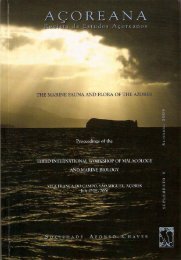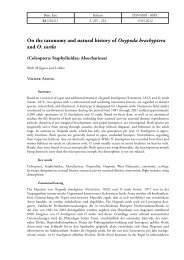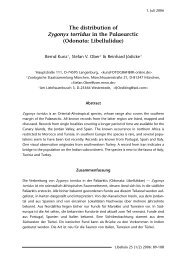(eds.) (2005). - Portal da Biodiversidade dos Açores - Universidade ...
(eds.) (2005). - Portal da Biodiversidade dos Açores - Universidade ...
(eds.) (2005). - Portal da Biodiversidade dos Açores - Universidade ...
Create successful ePaper yourself
Turn your PDF publications into a flip-book with our unique Google optimized e-Paper software.
Sumário: Os <strong>Açores</strong> constituem um arquipélago de<br />
nove ilhas oceânicas isola<strong>da</strong>s, onde os organismos<br />
terrestres chegaram através do vento, do mar, noutros<br />
animais e, nos tempos históricos, com a aju<strong>da</strong><br />
humana. Este capítulo analisa de forma detalha<strong>da</strong><br />
aquilo que se conhece sobre a biodiversi<strong>da</strong>de terrestre<br />
<strong>dos</strong> <strong>Açores</strong>. Para tal analisámos os quatro<br />
grandes grupos de organismos lista<strong>dos</strong> no capítulo<br />
4: Bryophyta (musgos, antocerotas e hepáticas),<br />
Pteridophyta e Spermatophyta (fetos e fanerogâmicas),<br />
Mollusca (lesmas e caracóis) e Arthropo<strong>da</strong><br />
(centopeias, diplópodes, crustáceos, aranhas,<br />
ácaros, insectos, etc.). O número total de espécies<br />
e/ou subespécies <strong>dos</strong> <strong>Açores</strong> pertencentes aos<br />
quatro grupos de organismos acima referi<strong>dos</strong> é de<br />
cerca de 3705 (3666 espécies e 224 subespécies).<br />
No entanto, adicionando outros grupos como os<br />
vertebra<strong>dos</strong> (Chor<strong>da</strong>ta, Vertebrata), anelídeos<br />
(Anneli<strong>da</strong>), nemáto<strong>dos</strong> (Nemato<strong>da</strong>) e líquenes,<br />
aquele número sobe para 4487 espécies e/ou subespécies<br />
(4443 espécies e 232 subespécies). O número<br />
total de espécies e/ou subespécies endémicas<br />
<strong>dos</strong> <strong>Açores</strong> pertencentes aos Bryophyta, Pteridophyta,<br />
Spermatophyta, Mollusca e Arthropo<strong>da</strong> totaliza<br />
as 393 (384 espécies e 44 subespécies). Os<br />
filos animais são os mais diversos em taxa endémicos<br />
(Mollusca = 49; Arthropo<strong>da</strong> = 267), com<br />
cerca de 80 % <strong>dos</strong> endemismos <strong>dos</strong> <strong>Açores</strong>. Deve<br />
ser ain<strong>da</strong> de assinalar a eleva<strong>da</strong> percentagem de<br />
endemismo nos caracóis e lesmas (Mollusca) terrestres<br />
<strong>dos</strong> <strong>Açores</strong>, com cerca de 44% de endemismo.<br />
As plantas vasculares possuem 68 endemismos<br />
e os briófitos 9. Usando um estimador não<br />
paramétrico, a estimativa conservadora <strong>da</strong> riqueza<br />
de taxa endémicos terrestres de briófitos, plantas<br />
vasculares, moluscos e artrópodes ron<strong>da</strong>rá 530<br />
taxa, pelo que apenas 77% <strong>dos</strong> endemismos <strong>dos</strong><br />
<strong>Açores</strong> serão conheci<strong>dos</strong>. Em apenas alguns géneros<br />
se verificou uma taxa de especiação eleva<strong>da</strong>, na<br />
sua maior parte pertencentes aos filos Mollusca e<br />
Arthropo<strong>da</strong>. A maior parte <strong>da</strong>s espécies de artrópodes<br />
e moluscos endémicos são conheci<strong>da</strong>s apenas<br />
de uma ilha, enquanto que, nas plantas, uma grande<br />
fracção <strong>da</strong>s espécies ocorre na maioria <strong>da</strong>s ilhas. A<br />
análise <strong>da</strong>s proporções <strong>da</strong>s várias categorias de<br />
colonização mostra que uma grande proporção <strong>da</strong><br />
24<br />
Abstract: The Azores is a remote oceanic<br />
archipelago of nine islands where the terrestrial<br />
organisms arrived by wind, on the sea, on other<br />
animals and on historical times by human assistance.<br />
This chapter highlights what we know about<br />
Azorean terrestrial biodiversity. Four important<br />
terrestrial taxonomic groups listed in Chapter 4 are<br />
analysed in detail: Bryophyta (mosses, liverworts),<br />
Pteridophyta and Spermatophyta (ferns and<br />
phanerogamics), Mollusca (slugs and snails) and<br />
Arthropo<strong>da</strong> (millipedes, centipedes, mites, spiders,<br />
insects, etc.). Currently the total number of<br />
terrestrial species and/or subspecies of the above<br />
mentioned orga-nisms in the Azores is estimated<br />
of about 3705 (3666 species and 224 subspecies).<br />
However, if we add other groups like vertebrates<br />
(Chor<strong>da</strong>ta, Vertebrata), annelids (Anneli<strong>da</strong>), nematodes<br />
(Nemato<strong>da</strong>) and lichens, this number reaches<br />
4487 species and/or subspecies (4443 species and<br />
232 subspecies). The total number of endemic<br />
species and/or subspecies from the Azores<br />
belonging to Bryophyta, Pteridophyta, Spermatophyta,<br />
Mollusca and Arthropod is about 393 (384<br />
species and 44 subspecies). The animals Phyla are<br />
the most diverse in endemic taxa (Mollusca = 49;<br />
Arthropo<strong>da</strong> = 267), comprising about 80% of the<br />
Azorean endemics. The percentage of endemism<br />
within Mollusca (44%) is remarkable. Vascular<br />
plants have 68 endemic species while bryophytes<br />
have 9 endemics. Using a non-parametric estimator<br />
we obtained a conservative estimate for endemic<br />
Azorean terrestrial vascular plants, bryophytes,<br />
molluscs and arthropods around 530 taxa, which<br />
means that only about 77% have already been<br />
described. In only some genera there was a<br />
substantial inter and intra-island speciation, most<br />
cases occurring in Mollusca and Arthropo<strong>da</strong>. Most<br />
of the endemic arthropods and molluscs are known<br />
in only one island, whereas in plants a large<br />
proportion of species occur in most islands. An<br />
analysis of the proportions of the colonization<br />
categories in arthropods and vascular plants shows<br />
that a major proportion of the species are<br />
introduced. Therefore, invasions of alien organisms<br />
are an actual and future environmental threat in<br />
the Azores, creating a pattern of biotic homo-

















